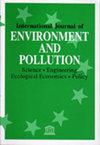Parameterisation study of chemically reactive pollutant dispersion over idealised urban areas based on the Gaussian plume model
IF 0.3
4区 环境科学与生态学
Q4 ENVIRONMENTAL SCIENCES
International Journal of Environment and Pollution
Pub Date : 2019-08-22
DOI:10.1504/IJEP.2019.10023401
引用次数: 2
Abstract
Dispersion of pollutants emitted from vehicles over urban areas largely affects pedestrian-level air quality. In this study, turbulent dispersion of reactive pollutants in the ABL over hypothetical urban areas in the form of idealised street canyons is investigated using large-eddy simulation (LES). Nitric oxide (NO) is emitted from the first street canyon into the urban ABL doped with ozone (O3). First of all, we make use of the advection-diffusion equation with chemical kinetics to derive the theoretical relation between the dispersion coefficients of tracer and reactive pollutants. Next, the source depletion analogy is used to determine the plume shape instead of the conventional Gaussian plume model. Finally, regression to the LES output unveils that the vertical dimensionless NO concentration profiles exhibit self-similarity for a range of background O3 concentrations. A new parameterisation of reactive plume dispersion over urban areas, whose performance is remarkable over the mean plume rise, is thus suggested.基于高斯羽流模型的理想城区化学反应性污染物扩散的参数化研究
车辆排放的污染物在城市地区的扩散在很大程度上影响了行人水平的空气质量。在这项研究中,使用大涡模拟(LES)研究了ABL中活性污染物在假设城市地区以理想化街道峡谷形式的湍流扩散。一氧化氮(NO)从第一个街道峡谷排放到掺有臭氧(O3)的城市ABL中。首先,我们利用具有化学动力学的平流-扩散方程,推导了示踪剂与活性污染物的扩散系数之间的理论关系。接下来,使用源贫化类比来确定羽流形状,而不是传统的高斯羽流模型。最后,对LES输出的回归表明,垂直无量纲NO浓度分布在一系列背景O3浓度下表现出自相似性。因此,提出了一种新的城市地区反应羽流扩散参数化方法,其性能在平均羽流上升过程中表现显著。
本文章由计算机程序翻译,如有差异,请以英文原文为准。
求助全文
约1分钟内获得全文
求助全文
来源期刊
CiteScore
1.10
自引率
0.00%
发文量
3
审稿时长
4.5 months
期刊介绍:
IJEP provides an international forum in the field of environment and pollution and addresses early and medium-term challenges involving scientific prediction, modelling and assessment. It focuses on ground-breaking research in the science of environmental pollution, at the early scientific stage. It is one of three key journals which together offer complete coverage of environmental issues: IJETM focuses on technical/engineering, policy and management solutions for environmental problems, and IJGEnvI focuses on future, longer-term environmental scenarios, ecological economics, climate change and biodiversity.

 求助内容:
求助内容: 应助结果提醒方式:
应助结果提醒方式:


